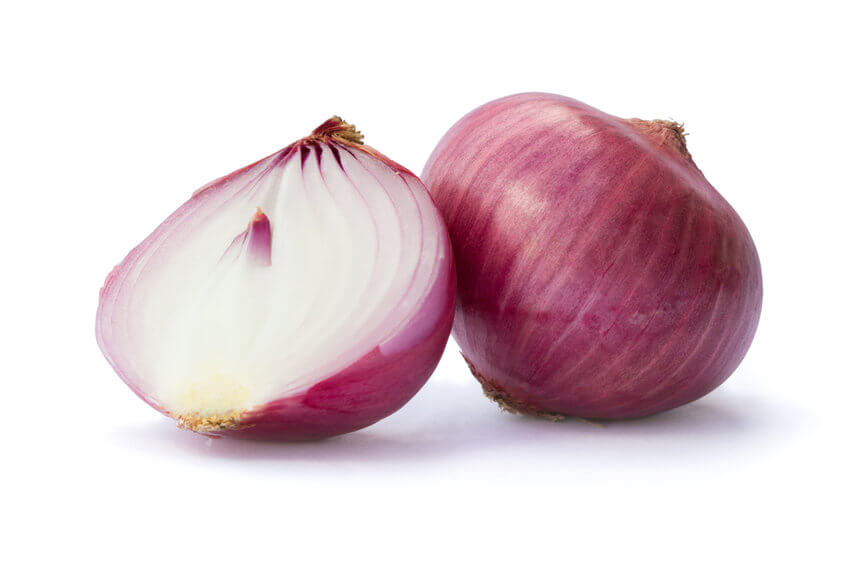Red and purple onions are a milder and sweeter variety of the Allium family. This makes them ideal for use in salads, wraps, and sandwiches as they’re the most suitable onion for eating raw. If you’ve ever wondered if there’s a difference between red onion vs purple onion though, then today you’re in luck as we will be covering this topic in detail.
As it turns out, the only difference between red onion vs purple onion is their name. Red and purple onions are the same vegetable. Most English-speaking countries refer to them as red onions, whereas some European nations use purple to describe them.
Let’s explore this a little further.
Red Onion VS Purple Onion
Red onions (also referred to as purple onions) are possibly the most unique of all onion varieties. They have a flaky, paper-like skin that varies in colors ranging from red to purple. Inside is a reddish flesh and white inner core.

Although red onions are more purple in color than red, they are referred to as red onions by most of the developed world. According to Wikipedia, however, mainland European countries (with the exception of the UK) refer to them as purple onions.
Red/purple onions have historically been used to create natural red dyes, which is where the “red onion” name originates from.
So while it is true that they have different names, there is no difference between red onion vs purple onion. They are the same vegetable.
What Gives Red/Purple Onions Their Color
One trait that makes red and purple onions so unique is their vibrant outer skin, which stands out among the dull, muted tones of most other onion varieties.
According to the Potandon Produce website, red onions and purple onions get their color from their antioxidant profile, which contains anthocyanins and flavonoids. This color can change when the onions are cooked due the effect of heat.
Furthermore, the quality and pH of soil used to grow them also plays a role, according to the Allrecipes website. The soil’s pH balance can have a significant impact on the shade and richness of the onion’s outer skin.
Does Color Indicate Freshness?
While it is true that red and purple onions can vary in shade, it is not an indication of how fresh the vegetable may be.
Instead, you can gauge the freshness of your onions by their touch. Fresh onions are on the firm side, whereas rotting onions tend to be soft and mushy, and can sometimes have brown spots.
How About Taste?
Some fruits and vegetables can vary in taste and texture depending on their color (such as bananas, for example.)
Seeing as how the variance in the color of red and purple onions has no effect on their freshness, you may be wondering if it impacts taste.
As it turns out, this is not the case. Red and purple onions should taste the same regardless of how red or purple they are. Any difference in taste is likely influenced by other factors.
How They’re Used
Red onions and purple onions are sometimes referred to as the salad onion. That is because this is the onion variety most commonly used in salads.
Unlike most other types of onions, red/purple onions have a milder and sweeter taste comparatively, making them the ideal onion for eating raw.
Culinary Uses
Red/Purple onions are used in a variety of dishes, including…
- As a salad topping
- On burgers and sandwiches
- In wraps
- Tacos
- Salsa
It should be noted that although red/purple onions are best eaten raw, that doesn’t mean you can’t cook them if you desire to. However, they do take a little longer to cook, and they do not have as much of a caramelization effect as yellow onions do.
A Natural Dye
One area where there may be a meaningful difference between red onion vs purple onion is when using them as a dye.
Thanks to the rich, vibrant color of their skin, red and purple onions can be used as a natural dye.
According to the All Natural Dyeing website, using these onions as a dye is advantageous because the tannins contained in their skin do the mordanting for you.
To use red and purple onions as a dye, all you have to do is place some of the skin in a pot of water and let it boil for roughly 40 minutes. Once cooled, the skins can be removed and you will have a natural red dye made from onion skins!
The Bottom Line
In conclusion, the difference between red onion vs purple onion is non-existent. Unless you’re going to use them as a natural dye, the variance in color has no impact on the onion’s taste or freshness.
Regardless of whether they’re red, purple, or any other color; onions make for a nutritious (and sometimes colorful) addition to any diet.

